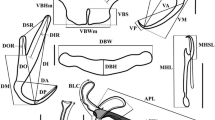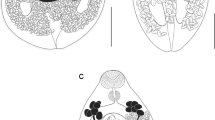Abstract
A new species of microphallid trematode was collected from the intestine of the yellow-crowned night heron Nyctanassa violacea (L.) (Pelecaniformes: Ardeidae) from Veracruz, Mexico. Maritrema kostadinovae n. sp. differs distinctly from other members of Maritrema Nicoll, 1907 from the Americas by its smaller body size (262–435 × 242–363 μm), the extension of caeca (reaching to anterior level of ventral sucker), the size and shape of the cirrus (short, tubular and unarmed) and metraterm (simple and thin-walled), the position of the genital pore (sinistrolateral to ventral sucker) and the arrangement of the vitellaria (horseshoe-shaped with posteriorly directed opening). Maximum likelihood and Bayesian inference analyses, based on partial 28S rDNA sequences, depicted M. kostadinovae n. sp. within the genus Maritrema with strong support. The new species is in a sister position to other available members of Maritrema, except for M. subdolum Jägerskiöld, 1909 that branches as the early divergent species in the Maritrema clade. The new species is the third species of Maritrema described from birds in Mexico. Comparative morphometric data for Maritrema taxa from birds and mammals from the Americas is provided.


Similar content being viewed by others
References
Arruda VS, Pinto RM, Muniz-Pereira LC (2001) New host and geographical records for helminths parasites of Ardeidae (Aves, Ciconiiformes) in Brazil. Rev Bras Zool 18:225–232. https://doi.org/10.1590/S0101-81752001000500018
Blasco-Costa I, Seppälä K, Feijen F, Zajac N, Klappert K, Jokela J (2020) A new species of Atriophallophorus Deblock & Rosé, 1964 (Trematoda: Microphallidae) described from in vitro-grown adults and metacercariae from Potamopyrgus antipodarum (Gray, 1843) (Mollusca: Tateidae). J Helminthol 94:e108. https://doi.org/10.1017/S0022149X19000993
Caballero E, Ibáñez CN (1970) Estudios helmintológicos de la República del Perú. I. Dos especies de trematoda de la familia Microphallidae Travassos, 1920 que parasitan a aves. An Inst Biol Univ Nac Autón Méx Ser Zool 41:29–38
Cable MR, Connor RS, Balling JW (1960) Digenetic trematodes of Puerto Rican shore birds. Sci Surv Porto Rico Virgin Islands 17:187–255
Capasso S, D’Amico VL, Diaz JI (2019) A new species of Maritrema (Trematoda: Microphallidae) parasitizing the Baird’s sandpiper Calidris bairdii, and comments about diversity of Microphallidae in two Nearctic shorebirds at Patagonian sites in Argentina. Acta Trop 189:10–14. https://doi.org/10.1016/j.actatropica.2018.09.018
Ching HL (1963) The description and life cycle of Maritrema laricola sp. n. (Trematoda: Microphallidae). Can J Zool 41:881–888. https://doi.org/10.1139/z63-058
Ching HL (1974) Two new species of Maritrema (Trematoda: Microphallidae) from the Pacific Coast of North America. Can J Zool 52:865–869. https://doi.org/10.1139/z74-117
Coil HW (1955) Notes on the genus Maritrema Nicoll, 1907 (Trematoda: Microphallidae) with the description of two new species. J Parasitol 41:533–537. https://doi.org/10.2307/3273816
Cremonte F, Martorelli SR (1998) Description of a new species of Maritrema (Digenea: Microphallidae) from Larus dominicanus (Aves: Laridae) in Buenos Aires coast, Argentina. Folia Parasitol 45:230–232
Darriba D, Taboada GL, Doallo R, Posada D (2012) jModelTest 2: more models, new heuristics and parallel computing. Nat Methods 9:772. https://doi.org/10.1038/nmeth.2109
Deblock S (1971) Contribution à l'étude des Microphallidae Travassos, 1920. XXIV. Tentative de phylogénie et de taxonomie. Bull Mus Nat Hist Nat Paris Zool 7:353–468
Deblock S (1972) Contribution à l’étude des Microphallidae Travassos, 1920 (Trematoda). XXIII. Les espèces décrites au Brésil par L. Travassos. Ann Parasitol Hum Comp 47:77–89. https://doi.org/10.1051/parasite/1972471077
Deblock S (1973) Contribution à l’étude des Microphallidae Travassos, 1920 (Trematoda). XXVII. A propos d’espèces décrites au Japon par S. Yamaguti: Invalidation du genre Maritreminoides Rankin. Création de genres satellites du genre Maritrema: Quasimaritrema, Maritremopsis et Quasimaritremopsis. Ann Parasitol Hum Comp 48:543–557. https://doi.org/10.1051/parasite/1973484543
Deblock S (2008) Family Microphallidae Ward, 1901. In: Bray RA, Gibson DI, Jones A (eds) Keys to the Trematoda, vol 3. CABI, Wallingford, pp 451–492
Deblock S, Canaris AG (1996) Microphallidae, Trematoda: XLVIII. - Quatre Maritrema du groupe Eroliae parasites d'Oiseaux australiens. Parasite 4:357–361. https://doi.org/10.1051/parasite/1996034357
Deblock S, Capron A (1960) Contribution à l’étude des Microphallidae Travassos, 1920 (Trematoda). IV. Le genre Maritrema: Description complémentaire de M. humile Nicoll, 1907, de M. linguilla et de M. subdolum Jaegerskioeld, 1909. Ann Parasitol Hum Comp 25:23–44. https://doi.org/10.1051/parasite/1960351023
Deblock S, Heard RW (1969) Contribution à l'étude des Microphallidae. Travassos, 1920 (Trematoda). XIX. Description de Maritrema prosthometra n. sp. et de Longiductotrema nov. gen. Ann Parasitol Hum Comp 44:415–424. https://doi.org/10.1051/parasite/1969444415
Deblock S, Rausch RL (1968) Contribution à l’étude des Microphallidae Travassos, 1920 (Trematoda). XVI. Description de Maritrema megametrios n. sp., parasite d’oiseaux de la côte ouest d’Amérique du Nord. Bull Soc Zool France 93:317–323
Diaz JI, Cremonte F (2010) Development from metacercaria to adult of a new species of Maritrema (Digenea: Microphallidae) parasitic in the kelp gull, Larus dominicanus, from the Patagonian coast, Argentina. J Parasitol 96:740–745. https://doi.org/10.1645/GE-2343.1
Diaz JI, Gilardoni C, Cremonte F (2012) Description of Maritrema formicae sp. nov. (Digenea, Microphallidae) parasitic in the kelp gull, Larus dominicanus, from the Patagonian coast, Argentina. Acta Parasitol 57:149–153. https://doi.org/10.2478/s11686-012-0019-4
Díaz MT, Bashirullah AK, Hernández LE (2004) A new species of Microphallus (Trematoda: Microphallidae) from Venezuela. Rev Biol Trop 52:363–370
Díaz MT, Ramos S, Hernández LE (1999) Maritrema eroliae parásito de aves limícolas del complejo lagunar Chacopata-Bocaripo, Estado Sucre, Venezuela. Saber 11:27–30
Etchegoin JA, Martorelli SR (1997) Description of a new species of Maritrema (Digenea: Microphallidae) from Mar Chiquita coastal lagoon (Buenos Aires, Argentina) with notes on its life cycle. J Parasitol 83:709–713. https://doi.org/10.2307/3284251
Etges FJ (1953) Studies on the life histories of Maritrema obstipum (Van Cleave and Mueller, 1932) and Levinseniella amnicolae n. sp. (Trematoda: Microphallidae). J Parasitol 39:643–662. https://doi.org/10.2307/3274085
Fernandes BMM, Justo MCN, Cárdenas MQ, Cohen SC (2015) South American trematodes parasites of birds and mammals. Oficina do Livro, Rio de Janeiro
Flores VR, Brugni NL, Pozzi CM (2012) A new microphallid (Digenea) species from Lontra provocax (Mammalia: Mustelidae) from freshwater environments of northwestern Patagonia (Argentina). J Parasitol 98:992–994. https://doi.org/10.1645/GE-2934.1
Forrester DJ, Spalding MG (2003) Parasites and diseases of wild birds in Florida. University Press of Florida, Gainesville
Guajardo-Martínez G (1984) Preliminary survey of parasites of Cuatro Ciénegas Coahuila, Mexico. J. Arizona-Nevada Acad Sci 19:81–83
Hadley CE, Castle RM (1940) Description of a new species of Maritrema Nicoll 1907, Maritrema arenaria, with studies of the life history. Biol Bull 78:338–348. https://doi.org/10.2307/1537782
Harkema R, Miller GC (1962) Helminth parasites of Procyon lotor from Cape Island, South Carolina. J Parasitol 48:333–335. https://doi.org/10.2307/3276029
Hernández-Orts JS, Pinacho-Pinacho CD, García-Varela M, Kostadinova A (2016) Maritrema corai n. sp. (Digenea: Microphallidae) from the white ibis Eudocimus albus (Linnaeus) (Aves: Threskiornithidae) in Mexico. Parasitol Res 115:547–559. https://doi.org/10.1007/s00436-015-4771-x
Kinsella JM, Deblock S (1994) Contribution à l’étude des Microphallidae Travassos, 1920 (Trematoda). XLVI. Description de Floridatrema heardi n. gen., n. sp., parasite d’Oryzomys palustris (Mammifere) des États-Unis. Parasite 1:39–44. https://doi.org/10.1051/parasite/1994011045
Kinsella JM, Deblock S (1997) Contribution à l’étude des Microphallidae (Trematoda). LI. De cinq espèces du plongeon imbrin Gavia immer (Aves) des Etats-Unis, dont Microphallus forresteri n. sp. Pluralité vraisemblable de l’espèce Microphallus nicolli (Cable & Hunninen, 1938). Syst Parasitol 37:139–148. https://doi.org/10.1023/A:1005758300795
Kudlai O, Cutmore SC, Cribb TH (2015) Morphological and molecular data for three species of the Microphallidae (Trematoda: Digenea) in Australia, including the first descriptions of the cercariae of Maritrema brevisacciferum Shimazu et Pearson, 1991 and Microphallus minutus Johnston, 1948. Folia Parasitol 62:053. https://doi.org/10.14411/fp.2015.053
Kudlai O, Cribb TH, Cutmore SC (2016) A new species of microphallid (Trematoda: Digenea) infecting a novel host family, the Muraenidae, on the northern Great Barrier Reef, Australia. Syst Parasitol 93:863–876. https://doi.org/10.1007/s11230-016-9670-8
Kumar S, Stecher G, Tamura K (2016) MEGA7: molecular evolutionary genetics analysis version 7.0 for bigger datasets. Mol Biol Evol 33:1870–1874. https://doi.org/10.1093/molbev/msw054
Olson PD, Cribb TH, Tkach VV, Bray RA, Littlewood DTJ (2003) Phylogeny and classification of the Digenea (Platyhelminthes: Trematoda). Int J Parasitol 35:733–755. https://doi.org/10.1016/S0020-7519(03)00049-3
Presswell P, Blasco-Costa I, Kostadinova A (2014) Two new species of Maritrema Nicoll, 1907 (Digenea: Microphallidae) from New Zealand: morphological and molecular characterisation. Parasitol Res 113:1641–1656. https://doi.org/10.1007/s00436-014-3809-9
Rambaut A (2018) Figtree (Version 1.4.4). Available at https://github.com/rambaut/figtree/releases. Accessed 19 Sept 2019
Rambaut A, Drummond AJ, Xie D, Baele G, Suchard MA (2018) Posterior summarisation in Bayesian phylogenetics using Tracer 1.7. Syst Biol 67:901–904. https://doi.org/10.1093/sysbio/syy032
Rauque CA, Flores VR, Brugni NL (2013) Maritrema patagonica n. sp. (Digenea: Microphallidae) cultured from metacercariae from freshwater anomuran, Aegla spp. (Decapoda: Aeglidae), in Patagonia. Comp Parasitol 80:196–202. https://doi.org/10.1654/4624.1
Ronquist F, Teslenko M, van der Mark P, Ayres DL, Darling A, Höhna S, Larget B, Liu L, Suchard MA, Huelsenbeck JP (2012) MrBayes 3.2: efficient Bayesian phylogenetic inference and model choice across a large model space. Syst Biol 61:539–542. https://doi.org/10.1093/sysbio/sys029
Stamatakis A (2006) RAxML-VI-HPC: maximum likelihood-based phylogenetic analyses with thousands of taxa and mixed models. Bioinformatics 22:2688–2690. https://doi.org/10.1093/bioinformatics/btl446
Swales WE (1933) On Streptovitella acadiae (gen. et spec. nov.). A trematode of the family Heterophyidae from the black duck (Anas rubripes). J Helminthol 11:115–118. https://doi.org/10.1017/S0022149X00001760
Thompson JD, Higgins DG, Gibson TJ (1994) CLUSTAL W: improving the sensitivity of progressive multiple sequence alignment through sequence weighting, position-specific gap penalties and weight matrix choice. Nucleic Acids Res 22:4673–4680. https://doi.org/10.1093/nar/22.22.4673
Tkach VV, Littlewood DTJ, Olson PD, Kinsella JM, Swiderski Z (2003) Molecular phylogenetic analysis of the Microphalloidea Ward, 1901 (Trematoda: Digenea). Sys Parasitol 56:1–15. https://doi.org/10.1023/A:1025546001611
Travassos L (1929) Une nouvelle espèce du genre Maritrema, Maritrema pulcherrima, n. sp. (Trematoda). Compt Rend Soc Biol Paris 100:945–946
Vargas-Arzola J, Segura-Salvador A, Reyes-Velasco L, Díaz-Chiguer DL, Márquez-Navarro A, León-Avila G, Ibañez-Cervantes G, Camacho AD, Sánchez-Manzano RM, Nogueda-Torres B (2014) Detection of Paragonimus mexicanus (Trematoda) metacercariae in crabs from Oaxaca, Mexico. Acta Trop 137:95–98. https://doi.org/10.1016/j.actatropica.2014.05.004
Violante-González J, Monks S, Quiterio-Rendon G, García-Ibáñez S, Larumbe-Morán E, Rojas-Herrera AA (2016) Life on the beach for a sand crab (Emerita rathbunae) (Decapoda, Hippidae): parasite-induced mortality of females in populations of the Pacific sand crab caused by Microphallus nicolli (Microphallidae). Zoosyst Evol 92:153–161. https://doi.org/10.3897/zse.92.8256
Watts BD (1995) Yellow-crowned night-heron (Nyctanassa violacea). In: Poole A, Gill F (eds) The Birds of North America, No. 161, The Academy of Natural Sciences and The American Ornithologists' Union, Washington, D.C., pp 1–24
Watts BD (2011) Yellow-crowned night-heron (Nyctanassa violacea). In: Poole AF (ed) The birds of North America online. Ithaca, Cornell Lab of Ornithology https://birdsna.org/Species-Account/bna/species/ycnher/introduction. Accessed 17 Dec 2019
Werding B (1973) Maritrema magdalenae n. sp., ein Trematode von der Isla de Salamanca, Nordkolumbien. Mitt Inst Colombo-Alemán Invest Cient 7:57–61
Acknowledgements
We are grateful to Sergio Martorelli and Bronwen Presswell for kindly providing literature on microphallids. We are indebted to David Hernández-Mena, Ivan Fiala and Pavla Bartošová-Sojková for their assistance with the phylogenetic analyses. The authors express their gratitude to Luis García Prieto, David Osorio Sarabia, Berenit Mendoza Garfias and Francisco E. Montero for their comments on the morphological characterization of the cirrus of the new species.
Funding
This study was supported in part by the Programa de Apoyo a Proyectos de Investigación e Innovación Tecnológica (PAPIIT No. IN207219) and the Czech Science Foundation (project ECIP P505/12/G112). JSH-O benefited from a postdoctoral fellowship of the National Council of Science and Technology (CONACYT), Mexico (postdoctoral number 177603).
Author information
Authors and Affiliations
Corresponding author
Ethics declarations
Conflict of interest
The authors declare that they have no competing interests.
Ethical approval
All applicable institutional, national and international guidelines for the care and use of animals were followed. Birds were collected under the collecting permit FAUT 0202 issued by the Secretaría de Medio Ambiente y Recursos Naturales (SEMARNAT) of Mexico to MGV.
Additional information
Section Editor: Hiroshi Sato
Publisher’s note
Springer Nature remains neutral with regard to jurisdictional claims in published maps and institutional affiliations.
Rights and permissions
About this article
Cite this article
Hernández-Orts, J.S., Capasso, S., Pinacho-Pinacho, C.D. et al. Morphological and molecular characterization of Maritrema kostadinovae n. sp. (Digenea: Microphallidae) from the yellow-crowned night heron Nyctanassa violacea (Aves: Ardeidae) in Mexico. Parasitol Res 119, 1785–1793 (2020). https://doi.org/10.1007/s00436-020-06682-8
Received:
Accepted:
Published:
Issue Date:
DOI: https://doi.org/10.1007/s00436-020-06682-8




